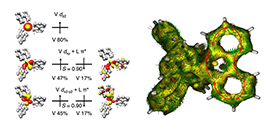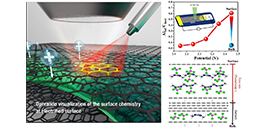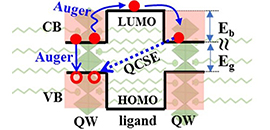Research News
-
 03 31, 2021A Tris-spiro Metalla-aromatic system Features Craig-Mobius AromaticityScientists synthesized and characterized a tris-spiroaromatic complex, hexalithio spiro vanadacycle.
03 31, 2021A Tris-spiro Metalla-aromatic system Features Craig-Mobius AromaticityScientists synthesized and characterized a tris-spiroaromatic complex, hexalithio spiro vanadacycle.
As aromaticity is one of the most fundamental concepts in chemistry, the construction of aromatic systems has long been an important subject.
Recently, Prof. YE Shengfa from the Dalian Institute of Chemical Physics of the Chinese Academy of Sciences, in collaboration with Prof. XI Zhenfeng from Peking University, synthesized and characterized a tris-spiroaromatic complex, hexalithio spiro vanadacycle.
Their study was published in nature communications on Feb 26.
Structure and EPR/MOs/AICD of complex (Image by JIANG Yang)
In most conventional organic aromatic compounds, aromaticity stems from the high degree of delocalization of π-electrons. Compared with carbon atoms, the d orbitals of transition metals have multiple orientations and flexible bonding modes.
Consequently, the introduction of transition metals into aromatic systems may bring new metalla-aromatic structures and extend the concept of aromaticity.
In this study, the scientists analyzed the electronic structure using electron paramagnetic resonance coupled with density functional calculations.
They found that the complex possessed a doublet ground state, and the unpaired electron primarily resides in the V center. The XPS measurements detected the oxidation state of V to be higher than +3.
DFT calculations elucidated that the complex represented an unprecedented 40π Craig-Mobius aromatic system that was realized by electron delocalization of four electrons within the two V 3d orbitals and thirty-six electrons arising from the π* orbitals of the three biphenyl ligands.
This research showed the participation of d orbitals in transition metals played a key role, leading to the special metalla-aromatic structures that have been found for organic aromatic compounds.
This work presents a novel spiroaromatic system that may contribute to both aromaticity theory and organometallic chemistry. (Text by JIANG Yang) -
 03 30, 2021Operando Surface Science Methodology Reveal Surface Effect in Charge Storage ElectrodesScientists reported the surface effect on aluminum ion battery (AIB) by operando surface science methodology.
03 30, 2021Operando Surface Science Methodology Reveal Surface Effect in Charge Storage ElectrodesScientists reported the surface effect on aluminum ion battery (AIB) by operando surface science methodology.
Surface and interface play critical roles in energy storage devices, thus calling for in-situ/operando methods to probe the electrified surface/interface.
However, the commonly used in-situ/operando characterization techniques such as X-ray diffraction (XRD), transmission electron microscopy (TEM), X-ray spectroscopy and topography, and nuclear magnetic resonance (NMR) are based on the bulk regions of the electrodes or electrolytes which overlook the critical surface/interface behaviors.
Recently, a research team led by Prof. FU Qiang from the Dalian Institute of Chemical Physics of the Chinese Academy of Sciences (CAS) reported the surface effect on aluminum ion battery (AIB) by operando surface science methodology.
The results were published in Natl. Sci. Rev. on March 21.
Super-dense intercalated anions together with cations in the surface region of graphite electrode have been visualized by operando surface science methodology over an Al/HOPG planar model device (Image by Chao Wang)
Surface science methodology established by Langmuir, Ertl, et al. has proven to be successful in providing a detailed description of how chemical reactions take place on solid surfaces. The applications of the surface science methodology on catalysis research have been made significant progresses but remain less explored and more challenging on electrified surface/interface.
In this work, based on well-designed planar Al/HOPG model battery and corresponding operando characterization cell/stage, multiple operando surface science characterizations including Raman, XPS, AFM and SKPM were performed over the model battery.
Super-dense intercalated anions (AlCl4-) together with cations (EMI+) in the surface region of the graphite electrode were visualized. The observed unusual electrochemical behavior in surface region could be described as the intercalation pseudocapacitor in contrast with the battery process in the bulk. The quantitative description of the electrochemical reactions of AIB and the distinct surface effect of the charge storage electrode were demonstrated by the operando surface science analysis.
Guided by this distinct surface effect, the capacity could be doubled by using surface-dominant nano-thick graphite electrode.
This research suggests a new strategy for operando studies of the surface chemistry over electrified surface/interface and highlights the significance of the surface effect in electrochemical devices.
This work was done in collaboration with Prof. WU Zhongshuai and Prof. LI Xianfeng from DICP and Prof. CHEN Liwei from Suzhou Institute of Nano-Tech and Nano-Bionics of CAS, Prof. GAO Chao from Zhejiang University and Prof. WU Chuan from Beijing Institute of Technology.
This work was supported by the National Natural Science Foundation of China, the National Key R&D Program of China, the Strategic Priority Research Program of the Chinese Academy of Sciences, and the DICP&QIBEBT funding. (Text by WANG Chao) -
 03 29, 2021Scientists Develop High-Performance Lithium-Ion Battery-Supercapacitor Hybrid DevicesScientists from DICP developed new BSHDs based on two matched faradaic electrodes with a rocking-chair mechanism analogous to lithium-ion batteries.
03 29, 2021Scientists Develop High-Performance Lithium-Ion Battery-Supercapacitor Hybrid DevicesScientists from DICP developed new BSHDs based on two matched faradaic electrodes with a rocking-chair mechanism analogous to lithium-ion batteries.
Battery-supercapacitor hybrid devices (BSHDs), which combine battery-type and capacitor-type electrodes in one cell, can fulfill the dual demands for high energy and power densities.
However, the performance of current BSHDs is restricted by the electrolyte-consuming mechanism and imbalance of charge-storage capacity and electrode kinetics between the two types of electrodes.
Recently, a research team led by Prof. WU Zhong-Shuai from the Dalian Institute of Chemical Physics of the Chinese Academy of Sciences developed new BSHDs based on two matched faradaic electrodes with a rocking-chair mechanism analogous to lithium-ion batteries.
This study was published online in Energy & Environmental Science on March 17.
Schematic illustration of the charge storage mechanisms for rocking-chair T-Nb2O5-NF//NCA-3D BSHD (Image by SU Feng)
The scientists developed these new BSHDs with a rocking-chair mechanism analogous to lithium-ion batteries by employing an intercalation pseudocapacitive T-Nb2O5 anode and a battery-type nickel-rich layered oxide (LiNi0.815Co0.15Al0.035O2) cathode with comparable faradaic capacities.
For electrode kinetics matching, they constructed a porous nanoflower structure and a three-dimensional interconnected conductive network formed by one-dimensional carbon nanotubes, two-dimensional electrochemically exfoliated graphene sheets, and conductive polymer binder for the anode and cathode, respectively. This facilitated BSHDs' charge transfer processes.
By virtue of doubly matched capacities and kinetics, the assembled BSHDs achieved superior performance to previously reported rocking-chair BSHDs and other counterparts with unmatched electrodes.
"This work could inspire cell configuration design and electrode structure optimization for high-energy and high-power electrochemical energy storage," said Prof. WU.
The above work was supported by National Natural Science Foundation of China, National Key R&D Program of China, Dalian National Laboratory for Clean Energy, CAS, etc. (Text by SU Feng and HOU Xiaocheng) -
 03 25, 2021High-performance Potassium Ion Micro-supercapacitors Developed for Wearable Pressure Sensor SystemScientists developed a new prototype of high-performance potassium ion micro-supercapacitors (KIMSCs) based on MXene-derived potassium titanate (KTO) nanorods as negative electrode and porous activated graphene (AG) as positive electrode in a non-flammable high-voltage ionogel electrolyte.
03 25, 2021High-performance Potassium Ion Micro-supercapacitors Developed for Wearable Pressure Sensor SystemScientists developed a new prototype of high-performance potassium ion micro-supercapacitors (KIMSCs) based on MXene-derived potassium titanate (KTO) nanorods as negative electrode and porous activated graphene (AG) as positive electrode in a non-flammable high-voltage ionogel electrolyte.
The development of flexible, wearable and implantable microelectronics has accelerated the need for miniaturized and integrated energy storage devices with mechanically robust properties, high voltage, and highly compatible integration.
Micro-supercapacitors (MSCs) have ultrahigh power density, fast charge and discharge rate, and long life stability, which hold a great potential for microelectronics. However, they suffer from relatively low energy density and narrow potential window.
Recently, a research team led by Prof. WU Zhongshuai from the Dalian Institute of Chemical Physics (DICP) of the Chinese Academy of Sciences developed a new prototype of high-performance potassium ion micro-supercapacitors (KIMSCs) to power the sensitively integrated pressure sensing system.
This work was published in Advanced Energy Materials on March 18.
Schematic of preparation of MXene-derived KTO nanorods and the fabrication of the integrated KIMSC-sensor system (Image by ZHENG Shuanghao)
The KIMSCs take MXene-derived potassium titanate (KTO) nanorods as negative electrode and porous activated graphene (AG) as positive electrode in a non-flammable high-voltage ionogel electrolyte, which serves as a sufficient microscale power source for the construction of an integrated sensor system.
The researchers prepared the KTO nanorods from the simultaneous alkalization and oxidation of Ti3C2 MXene via hydrothermal method. The KTO delivered a considerable diffusion coefficient of 1.6 × 10-12 cm2 s-1 and high capacity of 145 mAh g-1 as anode materials for K ion storage. The as-fabricated KIMSCs could offer a large operating voltage of 3.8 V, extraordinary volumetric energy density of 34.1 mWh cm-3, and mechanical robustness.
Moreover, they designed a highly integrated system based on KIMSC and a pressure sensor for efficiently monitoring the body movement of elbow and finger.
This work was supported by the National Natural Science Foundation of China, Dalian National Laboratory for Clean Energy of CAS. (Text by ZHENG Shuanghao and MA Jiaxin) -
 03 24, 2021Endothermic Charge-transfer Mediates Shallow Distance-dependent Triplet Energy Migration
03 24, 2021Endothermic Charge-transfer Mediates Shallow Distance-dependent Triplet Energy Migration
Recently, a research group led by Prof. WU Kaifeng from the Dalian Institute of Chemical Physics (DICP) of the Chinese Academy of Sciences (CAS) found that endothermic charge-transfer-mediated triplet energy transfer (TET) is a new mechanism featuring shallow distance-dependence.
This study was published in Nature Communications on March 9.
Shallow distance-dependent triplet energy migration from core/shell quantum dots to surface-anchored molecules mediated by endothermic charge-transfer (Image by LAI Runchen)
The researchers investigated TET from colloidal CdSe quantum dots (QDs), featuring systematically varied ZnS shell thicknesses, to surface-anchored anthracene molecules.
Time-resolved spectroscopy measurements showed no evidence for anthracene cation and/or anion formation, excluding exothermic charge transfer (CT)-mediated triplet migration.
The TET rate decreased with increasing ZnS shell thickness, with rate attenuation clearly following the trend of hole probability density on QD surfaces rather than the product of electron and hole probability densities. This observation evidenced an endothermic hole-transfer-mediated mechanism.
Temperature dependence of the transfer rate further confirmed the endothermic hole transfer process. The shallow distance dependence of endothermic CT-mediated TET enabled efficient triplet migration over donor-acceptor separation beyond Dexter or super-exchange paradigms.
The above work was supported by the National Natural Science Foundation of China, the Ministry of Science and Technology of China and the Chinese Academy of Sciences. (Text by LAI Runchen) -
 03 24, 2021Study Reveal Auger-assisted Electron Transfer Mechanism between Adjacent Quantum Wells in 2D Layered PerovskitesScientists revealed a new mechanism of Auger-assisted interlayer electron transfer in two-dimensional layered perovskites. It offers a new guideline to design 2D perovskites with an optically tunable QW-to-QW charge transport property.
03 24, 2021Study Reveal Auger-assisted Electron Transfer Mechanism between Adjacent Quantum Wells in 2D Layered PerovskitesScientists revealed a new mechanism of Auger-assisted interlayer electron transfer in two-dimensional layered perovskites. It offers a new guideline to design 2D perovskites with an optically tunable QW-to-QW charge transport property.
Two-dimensional (2D) perovskites are multiple quantum well (QW) structures formed by alternating inorganic and organic layers. They are promising in applications of solar cells, LEDs, and photodetectors.
However, due to the energy barrier exerted by the insulating organic ligands between QWs, the photogenerated excitons are usually confined in the perovskite QW plane and exhibit poor interlayer (QW-to-QW) carrier transport. That limits the further application of 2D perovskites in optoelectronic devices.
Recently, a research group led by Prof. JIN Shengye from the Dalian Institute of Chemical Physics (DICP) of the Chinese Academy of Sciences (CAS) revealed a new mechanism of Auger-assisted interlayer electron transfer in two-dimensional layered perovskites. It offers a new guideline to design 2D perovskites with an optically tunable QW-to-QW charge transport property.
This work was published in the Journal of the American Chemical Society on 18 March.
Auger-assisted electron transfer between adjacent quantum wells in 2D layered perovskites (Image by YIN Zixi and LENG Jing)
The scientists conducted pump-intensity dependent transient absorption experiments on a series of (CmH2m+1NH3)2PbI4 2D layered perovskites with different ligand alkyl chain lengths (m = 8, 10, 12, 18).
A longer ligand chain (larger m) led to an increased QW band gap energy (Eg) as well as a lower energy barrier (Eb) of electron transfer between the layers. When m≥12, where the value of Eb approaches Eg, a long-lived and derivative-like feature in the transient absorption (TA) spectra was observed. The similar TA spectral feature did not present in short-chain 2D perovskites with m≤12.
The scientists proposed a new Auger-assisted QW-to-QW electron transfer mechanism to explain the experimental results. When Eg ≈ Eb, the Auger recombination of an exciton could pump the electron in another exciton to transfer towards a neighboring QW through the barrier ligands. The separated electrons and holes built up an internal electric field and caused the derivative-like transient spectral feature through a quantum confined Stark effect.
This Auger-assisted electron transfer mechanism can be used to design novel layered 2D perovskites with either improved interlayer charge mobility or tunable optical properties, which may be finally utilized in photoelectronic and optical modulation devices.
This work was supported by the Ministry of Science and Technology, the National Natural Science Foundation of China, the Strategic Priority Research Program of CAS, and the Youth Innovation Promotion Association of CAS. (Text by YIN Zixi and LENG Jing)